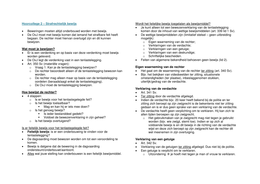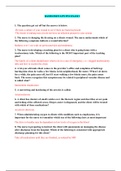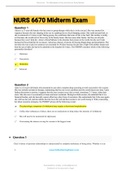CHAPTER 2 (SLATER & BREMNER) – THEORIES AND ISSUES IN CHILD
DEVELOPMENT
Theory of development: A scheme or system of ideas that is based on evidence and attempts
to explain, describe and predict behaviour and development
- Minor theory: Those which deal only with very specific, narrow areas of development
- Major theory: Those which attempt to explain large areas of development
MOTOR DEVELOPMENT
Motor milestones: The basic motor skills acquired in infancy and early childhood, such as
sitting unaided, standing, crawling and walking
Babies have a number of well-developed motor skills at birth – Skills that are vital for
survival – Uncoordinated inability and general weakness
Motor milestones emerge in a regular sequence + There is a considerable age range in which
individual infants acquire motor skills
Maturational theories: Children will go through the same stages of development, in the same
sequence but each child will go through the stages at their own rate – Maturation alone has
influence on motor development; experience has little effect – From global to specific
(Gesell)
- Cephalocaudal trend: From head to foot along the length of the body – Control of the
head is first, then the arms and trunk, and finally control of the legs
- Proximodistal trend: Motor control is from the centre of the body outwards to more
peripheral segments – Head, trunk and pelvic girdle are brought under control before
the elbow, wrist, knee and ankle joints, which in turn lead to finer control over hands
and fingers
Considerations that suggest that a maturational account of development can be dismissed:
1. McGraw: Research with pairs of twins where one member of each pair received
enriched motor training (in reaching, climbing stairs and other motor skills) – Found
that in the trained twin motor development was considerably accelerated
2. Advanced skills require more than genetic determination (such as playing the piano,
driving, typing and playing a sports)
3. A maturational theory does not account for the considerable individual differences in
the acquisition of various motor skills
Dynamic systems theories: All new motor development is the result of a dynamic interaction
of three major factors: (1) nervous system development, (2) the capabilities and biomechanics
of the body, (3) environmental constraints and support
- Kicking: Foot-kicking task – Infants are able to change their pattern of interlimb
coordination to solve a novel, experimentally imposed task – Operant conditioning
(Thelen)
- Reaching: Infants acquire stable control over the head several weeks before the onset
of reaching, then there is a reorganisation of muscle patterns so that the infants can
1
, stabilise the head and shoulder – Indication that infants need a stable posture before
they can attain the goal of reaching successfully – New motor skills are learned
through a process of modifying and developing their already existing abilities (Thelen
& Spencer)
- Walking: Newborns are top heavy, with big heads and weak legs – Over the coming
years their body weight is redistributed and their centre of mass gradually moves
downwards – As infants and children grow, they constantly adjust their motor
activities to accommodate the natural changes to their body dimensions – Infants do
not have a fixed understanding of their own abilities, but have the dynamic flexibility
to adjust their abilities as they approach a novel motor problem (Adolph & Avolio)
Research over the last 35 years has demonstrated that motor skills are learned, both during
infancy and throughout life
COGNITIVE DEVELOPMENT
Developmental psychology before Piaget:
- Behaviourism Mechanistic world view: The child is seen as the passive recipient of
- Psychoanalysis their upbringing
Piaget’s influence → Organismic world view: Children are active participants and continually
interact with their environment as to shape their own development – Constructivist theory:
Learners construct knowledge rather than just passively take in information; as people
experience the world and reflect upon those experiences, they build their own representations
and incorporate new information into their pre-existing knowledge
- Children’s behaviour and development is motivated largely intrinsically rather than
extrinsically
- Cognitive adaptations: Children’s developing cognitive awareness of the world –
Children acquire a better understanding of the world around them as a result of their
Functional invariants:
evolving
Processes do not change cognitive adaptations
- Ways for children to adapt to their environment:
during development
1. Assimilation: The process through which children incorporate new
experiences into their pre-existing schemes (= mental representations of bodily
movements or of something that a person can do with an object)
2. Accommodation: The cognitive process through which children adapt to new
experiences by modifying their pre-existing schemes
- Children as little scientists!
Sensorimotor stage: Birth to 2 years - Thought is limited to the infants’ own actions on the
old environment and based on perception and action
- Cognitive processes form the exercise of reflexes to the
beginning of symbolic functioning
- Development of thought in action – Infants learn to
solve problems
- Object permanence: Objects continue to exist even
though they cannot be seen or heard
2
, Preoperational stage: 2 to 7 years old - Representational insight: The knowledge that an entity
can stand for something other than itself
- Intelligence is symbolic instead of logical and is
expressed via language or imaginary modes
- Egocentric thought: Children find it difficult to see
things from another point of view
- Centration: The tendency to focus on one salient aspect
of a situation and neglect other aspects
- Animism: Attributing life and lifelike quantities to
inanimate objects
Concrete operational stage: 7 to 11 - Intelligence is symbolic and logical
years old - Thought becomes less egocentric but is limited to
concrete phenomena and past experiences
- Decentration: Children can separate themselves from a
specific aspect of a perceptual array and make
decisions based on the entire perceptual field
Formal operational stage: 11 to 16 - Children are able to make and test hypotheses, are able
years old to introspect about their own thought processes and are
able to think abstractly
INFORMATION-PROCESSING APPROACH
Information-processing theories: View the human mind as a complex system through which
information flows – Focus on the information available in the external environment, and the
means by which the child receives this information – The task of the child is to use their
perceptual systems to explore the world and obtain information – The information must be
attended to, encoded, stored, retrieved and acted upon to build knowledge
↓
Rooted in three 20th century innovations:
1. The rapid advances in computer technology
2. The view that an organism’s behaviour cannot be understood without knowing the
structure of the perceiver’s environment – The importance of environment and context
in learning – Perception is important because it allows humans to adapt to their
environment (Gibson)
3. Constructivism: Theory that says learners construct knowledge rather than just
passively take in information – Perception ‘fills in’ information that cannot be seen or
heard directly
Bottom-up: A cognitive development process that begins at the entry-level with what our
senses can detect – Sensory data and goes up to the brain's integration of this sensory
information – Purely data-driven (≠ top-down: Use of background knowledge and
expectations to interpret what we see)
↓
Information-processing theories assume a bottom-up approach, as children are limited in their
perceptual and sensory skills
3
, - Perception of causality:
- Temporal proximity: When an event is arranged so that the second ball moves
after a brief delay
- Physical proximity: When an event is arranged so that the second ball moves
before being contacted by the first ball
- 6-month-old infants do not seem to perceive the event as causal when either
temporal or physical proximity is violated – Higher-order
- 4-month-old infants were not able to discriminate between launching events
strictly on the basis of causality, but responded to the spatial and temporal
components of the event – Lower-order
- Unlike the older infants, younger infants would respond to the introduction or
removal of either a delay or a gap, regardless of how this change impacted the
causality of the event – Evidence for the development of causal perception
- Object unity: When two parts of an object are visible but its centre is hidden by
another object
- Younger infants perceive the components of the objects but not the wholes
- Unity perception is dependent on the extent to which infants actually look at
the object parts
Methods for understanding information at different levels:
1. Empirical studies of infants and children
2. Connectionist models: Computer programs designed to model some aspect of human
cognition, including cognitive development
3. Methods for recording brain activity
Similarities between information-processing theories and Piaget’s theory:
- Both attempt to specify children’s abilities and limitations as development proceeds
- Both try to explain how new levels of understanding develop from earlier, less
advanced ones
- Both focus on ‘active’ participation by the child in their own development – Children
learn by doing
Differences between information-processing theories and Piaget’s theory:
- Information processing approaches place great importance on the role of processing
limitations, whereas Piaget’s theory does not discuss processing limitations – Piaget
instead examined changes in terms of the child gradually creating logical frameworks
for thought
- Information processing approaches see development as continuous, whereas Piaget
suggests that development advances in multiple stages
SOCIAL-COGNITIVE DEVELOPMENT
Vygotsky: Social interactions plays an important role in child development
- Didactic relationship: Relationship based on instructive dialogue – Learning-design
relationship
- Higher mental abilities are first used in social interactions, and are internalised and
possessed as individual thought processes later on
4





